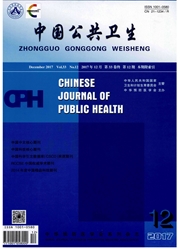

 中文摘要:
中文摘要:
目的探讨过氧化物酶增殖活化受体α(PPARα)和解偶联蛋白2(UCP-2)在非酒精性脂肪肝病(NAFLD)小鼠肝组织中的表达。方法雄性成年ICR小鼠30只随机分成3组,每组10只,即对照组(普通饲料)、模型A组(普通饲料4周+高脂饲料4周)、模型B组(高脂饲料8周),分别测定肝脏指数并制作肝脏病理切片,采用反转录.聚合酶链反应(RT—PCR)方法,测定小鼠肝组织中PPARet和UCP-2mRNA表达。结果对照组、模型A、B组小鼠肝指数分别为(3.89±0.87)%、(7.42±0.95)%、(9.38±1.07)%,模型组小鼠肝指数均高于对照组(P〈0.01),模型小鼠肝脏脂肪变性明显;模型A、B组小鼠肝组织中PPARetmRNA表达量分别为(0.63±0.33)、(0.45±0.19),低于对照组的(1.16±0.27)(P〈0.01),模型A、B组小鼠肝组织中UCP-2mRNA表达量分别为(0.67±0.76)、(0.89±0.52),高于对照组的(0.25±0.13)(P〈0.01)。结论发生NAFLD的小鼠肝组织中PPARd和UCP-2mRNA表达异常。
 英文摘要:
英文摘要:
Objective To explore the expressions of peroxisome proliferator-activated receptor α (PPARα) and un- coupling proteins 2 ( UCP-2 ) in hepatic tissue in the mice with non-alcohlic fatty liver disease ( NAFLD ). Methods Thirty mature male ICR mice were randomly divided into three groups ( 10 in each group). The mice in control group were fed with normal diet; the mice in experimental group A were fed with normal diet for 4 weeks; and then with high- fat diet for 4 weeks; and the mice in experimental group B were fed with high-fat diet for 8 weeks. Liver index were measured. The expressions of PPARa and UCP-2 mRNA in hepatic tissue were examined with reverse transcription poly- merase chain reaction( RT-PCR). Results The liver index for the mice in control group, experimental group A and ex- perimental group B were 3. 89 ±0. 87,7. 42 ±0. 95 ,and 9. 38 ±1.07 ,respectively. In the mice of experimental group,the liver index was significantly higher than that of the control mice( P 〈 0.01 ). The steatosis of hepatic tissue in experimen- tal group was obvious. PPARa mRNA expressions in hepatic tissue of mice of experimental group A(0. 63 ±0. 33 )and experimental group B ( 0.45 ±0. 19 ) were dramatically decreased compared to normal group ( 1.16 ± 0. 27 ) ( P 〈 0. 01 ). UCP-2 mRNA expressions in hepatic tissue of mice of experimental group A ( 0. 67 ± 0. 76 ) and experimental group B ( 0. 89 ± 0. 52 ) were dramatically increased compared to normal group ( 0. 25 ± 0. 13 ) ( P 〈 0. 01 ). Conclusion The ex- pression of PPAR a and UCP-2 in hepatic tissue of NAFLD mice are abnormal.
 同期刊论文项目
同期刊论文项目
 同项目期刊论文
同项目期刊论文
 Experimental nonalcoholic fatty liver disease in mice leads to cytochrome p450 2a5 upregulation thro
Experimental nonalcoholic fatty liver disease in mice leads to cytochrome p450 2a5 upregulation thro 期刊信息
期刊信息
